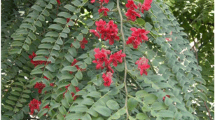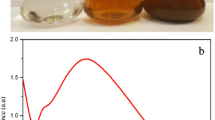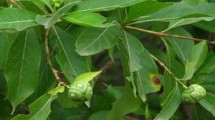Abstract
The current study aimed to assess the effectiveness of silver nanoparticles (AgNPs) synthesized using Alternanthera sessilis leaf extracts to control Aedes aegypti, Culex quinquefasciatus, and Anopheles stephensi mosquito larvae. The leaf extract of A. sessilis and 1 mM silver nitrate solution was used to initiate the synthesis of silver nanoparticles (AgNPs). The confirmation of AgNP synthesis was done through visual inspection and further confirmed by various instrumental analyses including UV–visible spectroscopy, Fourier transform infrared spectroscopy, X-ray diffraction, energy-dispersive X-ray spectroscopy, scanning electron microscopy (SEM), and transmission electron microscopy (TEM) with selected area electron diffraction (SAED). SEM and TEM analyses revealed that the synthesized AgNPs have an average size of 40–70 nm with spherical, hexagonal, and triangular shapes. Gas chromatography–mass spectrometry (GC–MS) and liquid chromatography–mass spectrometry (LC–MS) revealed various compounds which might be responsible for larvicidal activity. These biosynthesized AgNPs exhibited significant larvicidal activity after 72 h of exposure against three types of vectors, namely, An. stephensi (LC50 2.9 ppm and LC90 3.82 ppm), Cx. quinquefasciatus (LC50 2.82 ppm and LC90 7.21 ppm), and Ae. aegypti (LC50 2.93 ppm and LC90 7.63 ppm). After 72 h of exposure, moderate activity was seen in hexane extract with LC50 values of 17.02 ppm, 30.22 ppm, and 16.02 ppm and LC90 values of 31.63 ppm, 32.63 ppm, and 59.98 ppm against the larvae of Ae. aegypti, Cx. quinquefasciatus, and An. stephensi, respectively. The synthesized AgNPs were non-toxic against non-targeted species, Poecilia reticulata. This study demonstrates a rapid, cost-effective, eco-friendly, and single-step approach for the synthesis of A. sessilis–derived AgNPs. The improved larvicidal activity and their safe use against the non-target species present them as a promising candidate for vector control.



Similar content being viewed by others
Data availability
All data generated or analyzed during this study are included in this published article.
References
Dutta V, Sonu S, Raizada P, Thakur VK, Ahamad T, Thakur S, Kumar Verma P, Quang HHP, Nguyen VH, Singh P (2022) Prism-like integrated Bi2WO6 with Ag-CuBi2O4 on carbon nanotubes (CNTs) as an efficient and robust S-scheme interfacial charge transfer photocatalyst for the removal of organic pollutants from wastewater. Environ Sci Pollut Res 1–16
Kumar Y, Sudhaik A, Sharma K, Raizada P, Khan AAP, Nguyen VH, Ahamad T, Singh P, Asiri AM (2023) Construction of magnetically separable novel arrow down dual S-scheme ZnIn2S4/BiOCl/FeVO4 heterojunction for improved photocatalytic activity. J Photochem Photobiol A 435:114326
Habeeb Rahuman HB, Dhandapani R, Narayanan S, Palanivel V, Paramasivam R, Subbarayalu R, Thangavelu S, Muthupandian S (2022) Medicinal plants mediated the green synthesis of silver nanoparticles and their biomedical applications. IET Nanobiotechnol 16(4):115–144
Chawla A, Sudhaik A, Raizada P, Ahamad T, Van Le Q, Nguyen VH, Thakur S, Mishra AK, Selvasembian R, Singh P (2023) Bi-rich BixOyBrz-based photocatalysts for energy conversion and environmental remediation: a review. Coord Chem Rev 491:215246
Vala AK, Trivedi H, Gosai H, Panseriya H, Dave B (2021) Biosynthesized silver nanoparticles and their therapeutic applications. In Comprehensive analytical chemistry 94:547–584
Razack SA, Duraiarasan S (2020) A way to create a sustainable environment: Green nanotechnology–with an emphasis on noble metals. The ELSI handbook of nanotechnology: risk, safety. ELSI Commercialization 4:359–425
Athni TS, Shocket MS, Couper LI, Nova N, Caldwell IR, Caldwell JM, Childress JN, Childs ML, De Leo GA, Kirk DG, MacDonald AJ (2021) The influence of vector-borne disease on human history: socio-ecological mechanisms. Ecol Lett 24(4):829–846
Niang EH, Bassene H, Fenollar F, Mediannikov O (2018) Biological control of mosquito-borne diseases: the potential of Wolbachia-based interventions in an IVM framework. J Trop Med. https://doi.org/10.1155/2018/1470459
Féat A, Federle W, Kamperman M, van der Gucht J (2019) Coatings preventing insect adhesion: an overview. Prog Org Coat 134:349–359
Wangdi K, Banwell C, Gatton ML, Kelly GC, Namgay R, Clements AC (2016) Development and evaluation of a spatial decision support system for malaria elimination in Bhutan. Malar J 15:1–3
Yazdanian M, Rostamzadeh P, Rahbar M, Alam M, Abbasi K, Tahmasebi E, Tebyaniyan H, Ranjbar R, Seifalian A, Yazdanian A (2022) The potential application of green-synthesized metal nanoparticles in dentistry: a comprehensive review. Bioinorg Chem Appl. https://doi.org/10.1155/2022/2311910
Kuppusamy P, Yusoff MM, Maniam GP, Govindan N (2016) Biosynthesis of metallic nanoparticles using plant derivatives and their new avenues in pharmacological applications–an updated report. Saudi Pharm J 24(4):473–484
Yadav R, Saini H, Kumar D, Pasi S, Agrawal V (2019) Bioengineering of Piper longum L. extract mediated silver nanoparticles and their potential biomedical applications. Mater Sci Eng C Mater Biol Appl 104:109984
Rajput S, Kumar D, Agrawal V (2020) Green synthesis of silver nanoparticles using Indian Belladonna extract and their potential antioxidant, anti-inflammatory, anticancer and larvicidal activities. Plant Cell Rep 39:921–939
Shehzad A, Qayyum A, Rehman R, Nadeem F, Raffi M (2018) A review of bioactivity guided medicinal uses and therapeutic potentials of noxious weed (Alternanthera sessilis). Int J Chem Biochem Sci 14:95–103
Aasim M, Khawar KM, Ahmed SI, Karataş M (2019) Multiple uses of some important aquatic and semiaquatic medicinal plants. Plant and Human Health, Volume 2: Phytochemistry and Molecular Aspects. 541–77.
Kumar D, Kumar G, Das R, Agrawal V (2018) Strong larvicidal potential of silver nanoparticles (AgNPs) synthesized using Holarrhena antidysenterica (L.) Wall. bark extract against malarial vector, Anopheles stephensi Liston. Process Saf Environ Prot 116:137–148
World Health Organization (2005) Guidelines for laboratory and field testing of mosquito larvicide. https://apps.who.int/iris/handle/10665/69101.
Aarthi C, Govindarajan M, Rajaraman P, Alharbi NS, Kadaikunnan S, Khaled JM, Mothana RA, Siddiqui NA, Benelli G (2018) Eco-friendly and cost-effective Ag nanocrystals fabricated using the leaf extract of Habenaria plantaginea: toxicity on six mosquito vectors and four non-target species. Environ Sci Pollut Res 25:10317–10327
Finney DJ (1971) Probit Analysis. Cambridge University Press, London (1971), 68-72
Amarasinghe LD, Wickramarachchi PA, Aberathna AA, Sithara WS, De Silva CR (2020) Comparative study on larvicidal activity of green synthesized silver nanoparticles and Annona glabra (Annonaceae) aqueous extract to control Aedes aegypti and Aedes albopictus (Diptera: Culicidae). Heliyon 6(6):e04322
Bhatia D, Mittal A, Malik DK (2021) Antimicrobial potential and in vitro cytotoxicity study of polyvinyl pyrollidone-stabilised silver nanoparticles synthesised from Lysinibacillus boronitolerans. IET nanobiotechnol 15(4):427–40
Narayanan M, Priya S, Natarajan D, Alahmadi TA, Alharbi SA, Krishnan R, Chi NT, Pugazhendhi A (2022) Phyto-fabrication of silver nanoparticle using leaf extracts of Aristolochia bracteolata Lam and their mosquito larvicidal potential. Process Biochem 121:163–169
Kumar VA, Ammani K, Jobina R, Subhaswaraj P, Siddhardha B (2017) Photo-induced and phytomediated synthesis of silver nanoparticles using Derris trifoliata leaf extract and its larvicidal activity against Aedes aegypti. J Photochem Photobiol B 171:1–8
Loganathan S, Selvam K, Padmavathi G, Shivakumar MS, Senthil-Nathan S, Sumathi AG, Ali MA, Almutairi SM (2022) Biological synthesis and characterization of Passiflora subpeltata Ortega aqueous leaf extract in silver nanoparticles and their evaluation of antibacterial, antioxidant, anti-cancer, and larvicidal activities. J King Saud Univ-Sci 34(3):101846
Parthiban E, Manivannan N, Ramanibai R, Mathivanan N (2019) Green synthesis of silver-nanoparticles from Annona reticulata leaves aqueous extract and its mosquito larvicidal and anti-microbial activity on human pathogens. Biotechnol Rep 21:e00297
Kumar D, Kumar P, Vikram K, Singh H (2022) Fabrication and characterization of noble crystalline silver nanoparticles from Pimenta dioica leave extract and analysis of chemical constituents for larvicidal applications. Saudi J Biol Sci 29(2):1134–1146
Mondal A, Hajra A, Shaikh WA, Chakraborty S, Mondal NK (2019) Synthesis of silver nanoparticle with Colocasia esculenta (L.) stem and its larvicidal activity against Culex quinquefasciatus and Chironomus sp. Asian Pac J Trop Biomed 9(12):510
Rajkumar R, Shivakumar MS, Senthil Nathan S, Selvam K (2018) Pharmacological and larvicidal potential of green synthesized silver nanoparticles using Carmona retusa (Vahl.) Masam. leaf extract. J Cluster Sci 29:1243–1253
Govindan L, Anbazhagan S, Altemimi AB, Lakshminarayanan K, Kuppan S, Pratap-Singh A, Kandasamy M (2020) Efficacy of antimicrobial and larvicidal activities of green synthesized silver nanoparticles using leaf extract of Plumbago auriculata Lam. Plants 9(11):1577
Morejon B, Pilaquinga F, Domenech F, Ganchala D, Debut A, Neira M (2018) Larvicidal activity of silver nanoparticles synthesized using extracts of Ambrosia arborescens (Asteraceae) to control Aedes aegypti L. (Diptera: Culicidae). J Nanotechnol 10.1155 /2018/6917938.
Madhankumar R, Sivasankar P, Kalaimurugan D, Murugesan S (2020) Antibacterial and larvicidal activity of silver nanoparticles synthesized by the leaf extract of Andrographis serpyllifolia wight. J Cluster Sci 31:719–726
Liao C, Li Y, Tjong SC (2019) Bactericidal and cytotoxic properties of silver nanoparticles. Int J Mol Sci 20:449
Vinoth S, Shankar SG, Gurusaravanan P, Janani B, Devi JK (2019) Anti-larvicidal activity of silver nanoparticles synthesized from Sargassum polycystum against mosquito vectors. J Cluster Sci 30:171–180
Khader SZ, Syed Zameer Ahmed S, Sathyan J, Mahboob MR, Venkatesh KP, Ramesh K (2018) A comparative study on the larvicidal potential of selected medicinal plants over green synthesized silver nanoparticles. Egypt J Basic Appl Sci 5(1):54–62
Foko LP, Hawadak J, Verma V, Kedi PB, Moukoko CE, Kamaraju R, Pande V, Singh V (2023) Phyto-fabrication and characterization of Alchornea cordifolia silver nanoparticles and evaluation of antiplasmodial, hemocompatibility and larvicidal potential. Front Bioeng Biotechnol 11:1109841
Pratheeba T, Vivekanandhan P, Faeza AN, Natarajan D (2019) Chemical constituents and larvicidal efficacy of Naringi crenulata (Rutaceae) plant extracts and bioassay-guided fractions against Culex quinquefasciatus mosquito (Diptera: Culicidae). Biocatal Agric Biotechnol 19:101137
Anil Kumar V, Ammani K, Jobina R, Parasuraman P, Siddhardha B (2016) Larvicidal activity of green synthesized silver nanoparticles using Excoecaria agallocha L. (Euphorbiaceae) leaf extract against Aedes aegypti. IET nanobiotechnol 10(6):382–388
Suman TY, Rajasree SR, Jayaseelan C, Mary RR, Gayathri S, Aranganathan L, Remya RR (2016) GC-MS analysis of bioactive components and biosynthesis of silver nanoparticles using Hybanthus enneaspermus at room temperature evaluation of their stability and its larvicidal activity. Environ Sci Pollut Res 23:2705–2714
Kalimuthu K, Panneerselvam C, Murugan K, Hwang JS (2013) Green synthesis of silver nanoparticles using Cadaba indica lam leaf extract and its larvicidal and pupicidal activity against Anopheles stephensi and Culex quinquefasciatus. J Entomol Acarological Res 45(2):e11. https://doi.org/10.4081/jear.2013.e11
Adesuji ET, Oluwaniyi OO, Adegoke HI, Moodley R, Labulo AH, Bodede OS, Oseghale CO (2016) Investigation of the larvicidal potential of silver nanoparticles against Culex quinquefasciatus: a case of a ubiquitous weed as a useful bioresource. J Nanomater. https://doi.org/10.1155/2016/4363751
Arjunan NK, Murugan K, Rejeeth C, Madhiyazhagan P, Barnard DR (2012) Green synthesis of silver nanoparticles for the control of mosquito vectors of malaria, filariasis, and dengue. Vector Borne Zoonotic Dis 12(3):262–268
Elumalai D, Hemalatha P, Kaleena PK (2017) Larvicidal activity and GC–MS analysis of Leucas aspera against Aedes aegypti Anopheles stephensi and Culex quinquefasciatus. J Saudi Soc Agric Sci 16(4):306–313
Prabakar K, Jebanesan A (2004) Larvicidal efficacy of some cucurbitaceous plant leaf extracts against Culex quinquefasciatus (Say). Bioresour Technol 95:113–114
Sharma P, Mohan L, Srivastava C (2009) Amaranthus oleracea and Euphorbia hirta: natural potential larvicidal agents against the urban Indian malaria vector, Anopheles stephensi Liston (Diptera: Culicidae). Parasitol Res 106:171–176
Singh RK, Dhiman RC, Mittal PK (2007) Studies on mosquito larvicidal properties of Eucalyptus citriodora Hook (family-Myrtaceae). J Commun Dis 39(4):233–236
Cnubben NH, Rietjens IM, Wortelboer H, van Zanden J, van Bladeren PJ (2001) The interplay of glutathione-related pro-cesses in antioxidant defense. Environ Toxicol Pharmacol 10:141–152. https://doi.org/10.1016/S1382-6689(01)00077-1
Yasur J, Rani PU (2015) Lepidopteran insect susceptibility to silver nanoparticles and measurement of changes in their growth, development and physiology. Chemosphere 124:92–102. https://doi.org/10.1016/j.chemosphere.2014.11.029
Parthiban E, Ramachandran M, Jayakumar M, Ramanibai R (2019) Biocompatible green synthesized silver nanoparticles impact on insecticides resistant developing enzymes of dengue transmitted mosquito vector. SN Appl Sci 1:1–9
Govindarajan M, Rajeswary M, Hoti SL, Nicoletti M, Benelli G (2016) Facile synthesis of mosquitocidal silver nanoparticles using Mussaenda glabra leaf extract: characterization and impact on non-target aquatic organisms. Nat Prod Res 30(21):2491–2494
Kumar D, Kumar G, Agrawal V (2018) Green synthesis of silver nanoparticles using Holarrhena antidysenterica (L.) Wall. bark extract and their larvicidal activity against dengue and filariasis vectors. Parasitol Res 117:377–389
Benelli G, Kadaikunnan S, Alharbi NS, Govindarajan M (2018) Biophysical characterization of Acacia caesia-fabricated silver nanoparticles: effectiveness on mosquito vectors of public health relevance and impact on non-target aquatic biocontrol agents. Environ Sci Pollut Res 25:10228–10242
Acknowledgements
The authors are grateful to the Director ICMR-National Institute of Malaria Research, Dwarka Sector 8, and New Delhi for providing the necessary infrastructure and support during the research work of this study. Dinesh Kumar is indebted to the Indian Council of Medical Research for awarding ICMR Research Associate and Post-Doctoral Research Fellowship.
Funding
The research work in this publication was supported by ICMR, New Delhi, through project no. 3/1/3/PDF (20)/2019-HRD.
Author information
Authors and Affiliations
Contributions
DK and HS: investigation, writing—original draft, conceptualization, methodology, and formal analysis. BS and KV: validation and investigation. GK: validation and investigation. HS, RS, and AR: writing, review, editing, and supervision. All authors read and approved the final manuscript.
Corresponding author
Ethics declarations
Ethical approval
Not applicable.
Competing interests
The authors declare no competing interests.
Additional information
Publisher's Note
Springer Nature remains neutral with regard to jurisdictional claims in published maps and institutional affiliations.
The explained research work has not been published elsewhere and is not under consideration by another journal. It has been approved by all co-authors for publication in this Journal.
About this article
Cite this article
Kumar, D., Singh, B., Kumar, G. et al. Phyto-fabrication and characterization of Alternanthera sessilis leaf extract–mediated silver nanoparticles and evaluation of larvicidal potential. Biomass Conv. Bioref. (2023). https://doi.org/10.1007/s13399-023-04948-6
Received:
Revised:
Accepted:
Published:
DOI: https://doi.org/10.1007/s13399-023-04948-6




